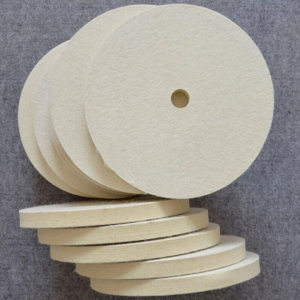In the dynamic world of manufacturing and crafting, the wool felt wheel has emerged as a game-changer, revolutionizing surface finishing processes across various industries. This unassuming yet highly effective tool is quickly becoming a favorite among professionals and hobbyists alike, thanks to its unique properties and versatile applications.
Wool felt wheels are crafted from natural wool fibers, which are compressed and felted to create a dense, durable material. This composition gives the wheels several distinct advantages over their synthetic counterparts. One of the key benefits is their exceptional softness. The fine wool fibers are gentle on surfaces, making them ideal for polishing delicate materials such as jewelry, glass, and precious metals. Unlike harsher abrasive wheels, wool felt wheels can achieve a high – gloss finish without causing scratches or damage, ensuring that the integrity of the workpiece is maintained.
Another significant advantage of wool felt wheels is their heat – resistant properties. During the polishing and buffing process, friction can generate a substantial amount of heat, which can warp or damage certain materials. Wool felt, however, has excellent heat – dissipating capabilities, allowing it to withstand high temperatures without deforming. This makes it suitable for applications where heat management is crucial, such as in automotive paint finishing or metalworking, where maintaining the quality of the surface is essential.
The versatility of wool felt wheels is truly remarkable. In the automotive industry, they are used to restore the shine of car paint, remove oxidation, and repair minor scratches. A 4 – inch wool felt wheel, for example, can be attached to an angle grinder or a polishing machine to efficiently buff the car’s surface, giving it a showroom – like finish. In the jewelry making business, jewelers rely on small, soft wool felt wheels to polish precious stones and metals, enhancing their luster and beauty.
For woodworking enthusiasts, wool felt wheels play a vital role in achieving a smooth and professional finish. Whether it’s a handmade wooden table or a piece of fine furniture, these wheels can be used to apply finishes, waxes, and sealants evenly, resulting in a flawless surface. In the metalworking industry, wool felt wheels are employed for deburring, burnishing, and removing rust from metal components, improving both the appearance and functionality of the parts.
The market for wool felt wheels is also experiencing significant growth. With the increasing demand for high – quality surface finishing in various sectors, manufacturers are constantly innovating to meet the needs of their customers. Some are producing eco – friendly wool felt wheels, using sustainable wool sources and minimizing the environmental impact. Others are focusing on developing wheels with different densities and thicknesses to cater to specific applications, such as thick wool felt wheels for heavy – duty polishing tasks or fine wool felt wheels for more intricate work.
However, with the growing popularity of wool felt wheels, it’s important for users to know how to choose the right one. Factors such as the type of material to be polished, the desired finish, and the power of the tool being used all need to be considered. Additionally, proper maintenance of the wool felt wheel is crucial to ensure its longevity and performance. Regular cleaning to remove debris and replacing the wheel when it becomes worn out are essential practices.
In conclusion, the wool felt wheel has firmly established itself as an indispensable tool in the world of surface finishing. Its combination of natural materials, unique properties, and wide – ranging applications makes it a valuable asset for professionals and DIY enthusiasts. As technology continues to advance and the demand for high – quality finishes grows, the future looks bright for the wool felt wheel, with even more innovative uses and improvements on the horizon.

Post time: Jun-05-2025
